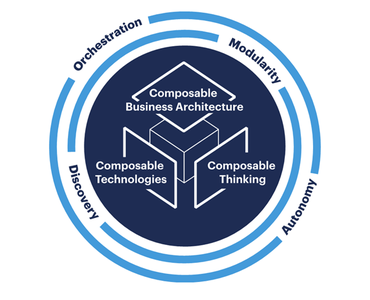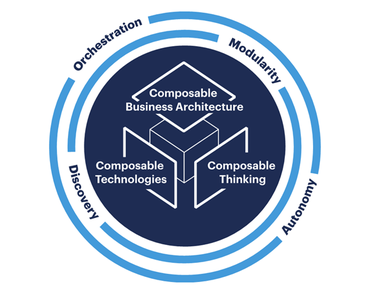As we begin to look at the future beyond “the new normal,” it’s becoming apparent that we are in a brand new era of digital experiences that are frictionless and highly personalized. The future of next generation business applications will be scalable, composable, connected and powered by machine learning. These next generation applications will have integrated voice and video capabilities, with a unified platform model that is designed for fast development, deployment and optimization based on specific industry requirements. The most important currencies in a decentralized and digital economy are speed, personalization and intelligence.
Scalable, Composable, Connected and Industry Specific Applications
According to Gartner, a composable business means creating an organization made from interchangeable building blocks. Next generation business applications must also be made from interchangeable blocks. The idea of composable business, according to Gartner, operates on four basic principles: 1. More speed through discovery, 2. Greater agility through modularity, 3. Better leadership through orchestration, 4. Resilience through autonomy.
According to Gartner, the three building blocks of composable business are:
Composable thinking, which keeps you from losing your creativity. Anything is composable. When you combine the principles of modularity, autonomy, orchestration and discovery with composable thinking, it should guide your approach to conceptualizing what to compose, and when.Composable business architecture ensures that your organization is built to be flexible and resilient. It’s about structure and purpose. These are structural capabilities — giving you mechanisms to use in architecting your business.Composable technologies are the tools for today and tomorrow. They are the pieces and parts, and what connects them all together. The four principles are product design goals driving the features of technology that support the notions of composability.

Gartner: The three building blocks of composable business are: business architecture, thinking and technologies.
Next generation business applications are composable and connected. Developing next generation apps — voice, video and industry specific applications powered by AI technologies like machine learning, deep learning, natural language processing, computer visioning — which require scale, security and integration are challenging IT organizations more than ever before.
Next Generation App Development Challenges and Opportunities
Next generation business application development is at risk — stronger workload and demand on IT, technical skills shortages, and platform scale and integration requirements. 2021 IT leadership research shows that IT workloads have increased during the pandemic. 88% of IT leaders say workloads have increased in the past 12 months. 60% of IT leaders who said their workload increased have noted an increase of more than half. The need for IT innovation takes on new urgency in the post-pandemic world. The pandemic created a tipping point for IT. Business demands on IT increased as remote work replaced office norms, and the majority of IT teams failed to deliver on all project commitments. Today, IT is under tremendous pressure to transform in order to move faster. Just 37% of organizations say IT completed all the projects asked of them last year.
Innovation is at risk as IT demand rise. 92% of IT leaders say their work increasingly impacts the business. Another 96% of IT leaders say there is increased demand from the business for new apps and processes. 70% of IT leaders are concerned that increased workloads will curb their ability to innovate. According to recent 2021 research, 88% of customers expect companies to accelerate digital initiatives due to COVID-19.
Tool proliferation and disconnected data make development more difficult. 72% of IT leaders say the number of tools needed to build apps/processes slow down production. This burden on IT has led to a greater acceptance of business-led application development. Application redeployment and low-code development are viewed as the way forward. 95% of IT leaders are interested in tech that helps build apps/processes that can be reused multiple times. Another 83% of IT leaders plan to increase their use of low-code development tools. 81% of IT leaders believe business users at their organization would build their own apps and processes if permitted. Further, 83% of IT leaders believe responsibility for some app and process development will increasingly shift to business users. And 92% of IT leaders are comfortable with the use of low-code tools by business users, assuming proper training, governance, and processes.
2021 IT leadership research identified the benefits of business-led development of next generation applications with low-code/no-code tools. The benefits included:
Provide new ways for IT to partner with the businessIncrease process automationBridge business requirements and technical executionIncrease development speedIncrease IT staff productivityAllow technical staff to concentrate on complex tasksIncrease ability to redeploy appsReduce the backlog of IT projectsReduce shadow IT
Ecosystem-Led Next Generation Application Development Enablement
Enterprises will look to low code development tools to improve productivity. Per Gartner, 75% of large enterprises will be using at least four low-code development tools for both IT application development and citizen development initiatives, by 2024. And 65%+ of application development activity will be as a result of low-code application development, by 2024. These trends are incredibly important for IT and CIOs — enabling and increasing technology savviness across lines-of-business is a key priority. Citizen integrator tools will reach mainstream adoption in the next 2 to 5 years.
Automation is top of mind to enable innovation. Per Salesforce, 81% of IT organizations will automate more tasks to allow team members to focus on innovation over the next 12 months to 18 months. McKinsey notes 57% of organizations say they are at least piloting automation of processes in one or more business units or functions. MuleSoft research found 30% of IT decision-makers say that automation is a key business initiative tied to digital transformation. McKinsey estimates that automation could raise productivity in the global economy by up to 1.4% annually. Companies across industries are experimenting with automation. Across all industries, 60% of line of business users agree that an inability to connect systems, applications and data hinders automation initiatives.
How can companies leverage technology business partners to accelerate automation and to build, deploy and integrate next generation business applications faster? At my company, Salesforce, our partnership with Amazon AWS enables us to deliver integrated product offerings to customers and a shared global developer community. Simple, scalable, and integrated composable cloud solutions enable businesses to build, deploy and integrate faster, creating better customer experiences with a unified platform. The goal is to drive faster time-to-value with pre-built applications using out-of-box applications and add-ons that utilize Salesforce and AWS services for voice, video, and productivity infused with AI.
Salesforce and AWS enable customers of all sizes, across industries, to benefit from complementary, integrated product offerings, aligned go-to-market (GTM), and shared global developer communities. Use of low-code and code-based development tools, coupled with data visualization tools, accelerate app development. The unified platform will also accelerate automation capabilities. Industry focused applications, powered by voice and video embedded applications that are powered by machine learning capabilities will turbo charge decision velocity and sales, services, marketing and digital commerce teams to co-create value at the speed of need.
The demand for next generation application development far exceeds the delivery capabilities of most IT organizations. And the demand for IT to innovate and deliver next gen apps will continue to grow in 2021. Technology leaders must develop an ecosystem strategy and invite the opportunity to develop new applications that are scalable, secure, composable, connected and well integrated. The guiding principle is to deliver value at the speed of stakeholder need. The only way to build a strong long-term innovation strategy is to lean into partnerships, platforms and customer success priorities.



